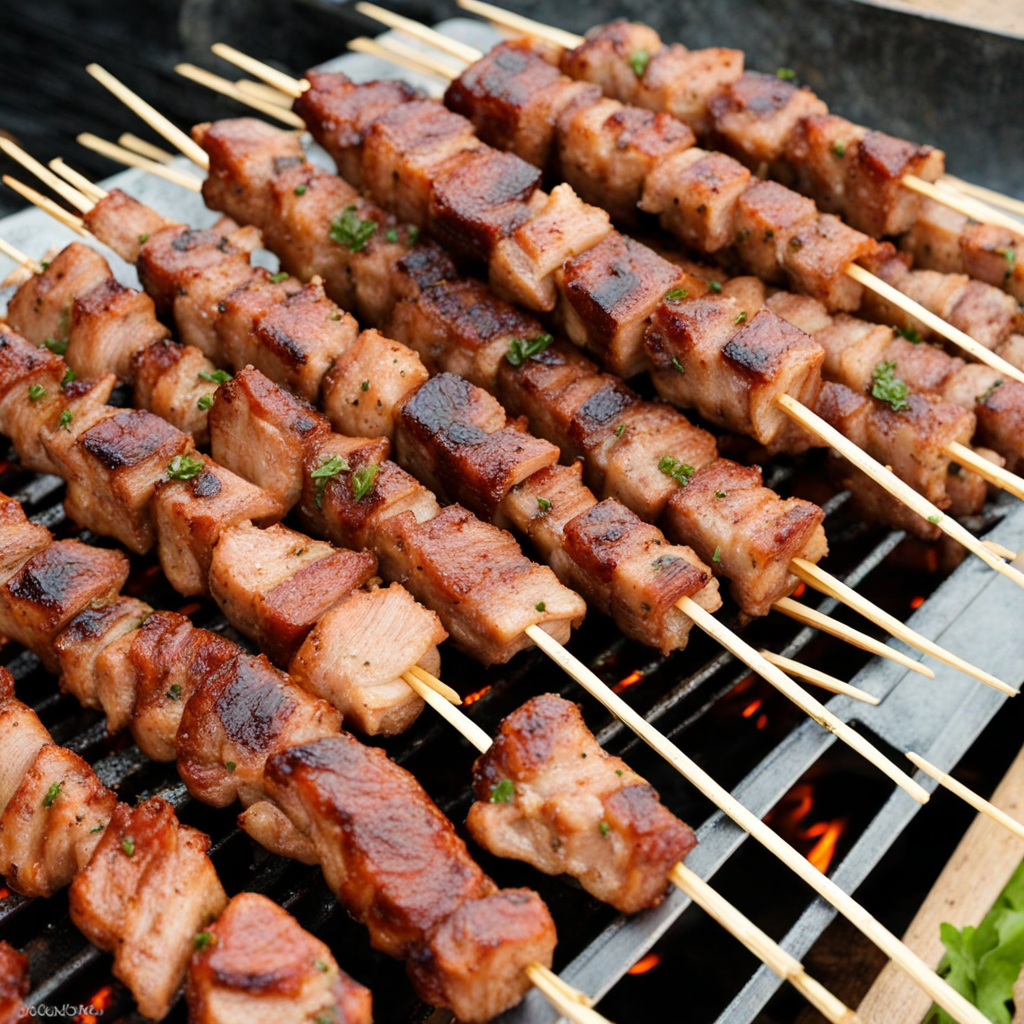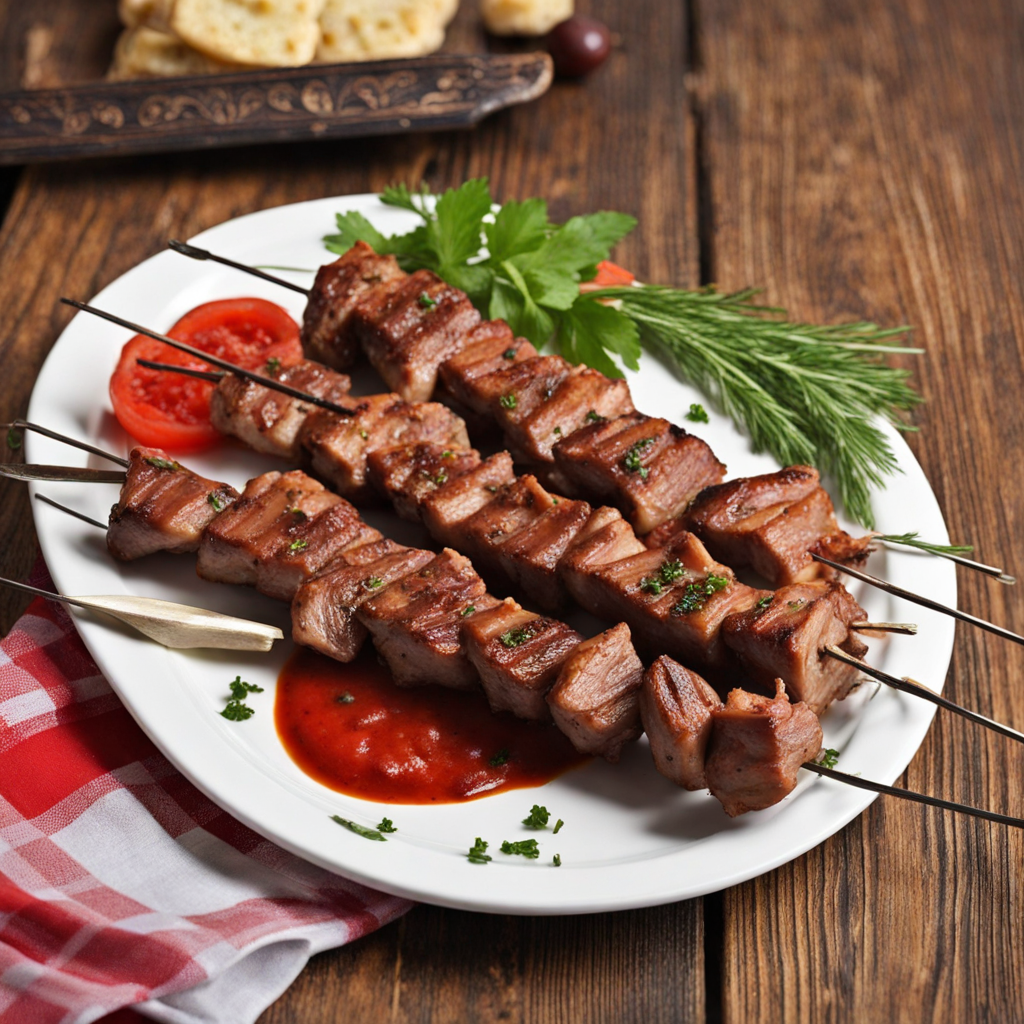Raznjici
Raznjici is a delightful culinary gem from Kosovo, known for its rich flavors and comforting essence. This dish features skewered meat, typically made from marinated pork, beef, or chicken, which is grilled to perfection. The marinade often consists of a blend of spices, including paprika, garlic, and various herbs, imparting a unique depth of flavor that tantalizes the taste buds. The sizzling meat is often served hot off the grill, showcasing its juicy tenderness and smoky aroma that instantly draws you in. What makes Raznjici particularly special is the way it is enjoyed. It is commonly served with a side of flatbread, known as 'pita', and accompanied by fresh salads or roasted vegetables that complement the savory meat. The contrast of textures between the crispy, charred exterior of the Raznjici and the soft, warm pita creates a satisfying eating experience. Each bite is a burst of flavor, making it an ideal dish for gatherings, barbecues, or simply a comforting meal at home. While Raznjici is often enjoyed as a main dish, it can also be shared as part of a mezze spread, allowing you to explore other traditional Kosovar dishes alongside it. The communal aspect of sharing this dish enhances its appeal, as friends and family come together to savor the glorious flavors. With its vibrant taste and heartwarming qualities, Raznjici is not just a meal; it's an experience that invites you to delve into the culinary traditions of Kosovo.
How It Became This Dish
Ražnjići: A Culinary Journey Through Kosovo’s History #### Origins of Ražnjići Ražnjići, the beloved skewered meat dish from Kosovo, boasts a rich history that reflects the region's diverse cultural tapestry. The word "ražnjići" is derived from the Serbian term for "skewers," and it is primarily made with marinated meat, typically pork, beef, or lamb, which is threaded onto metal or wooden skewers and grilled to perfection. The dish has roots that can be traced back to the Ottoman Empire, which dominated the Balkans for nearly five centuries. During this period, culinary practices were profoundly influenced by the exchange of spices, cooking techniques, and flavors among various cultures. The concept of grilling meat on skewers likely originated from Middle Eastern cuisines, which were brought to the region by Ottoman invaders and settlers. This method of cooking was not only practical for nomadic tribes but also added a unique flavor profile to the meat. #### Cultural Significance Ražnjići is more than just a dish; it serves as a cultural symbol of hospitality and community in Kosovo. It is often prepared during family gatherings, celebrations, and communal feasts. The act of grilling ražnjići becomes a social event, where families and friends gather around the grill, sharing stories and laughter while enjoying the tantalizing aroma of the meat sizzling over an open flame. In Kosovo, food is a powerful expression of identity, and ražnjići embodies this sentiment. It has become synonymous with traditional Balkan grilling and is often featured in local festivals and celebrations, such as weddings and religious holidays. The dish is also a staple in many restaurants across the region, where it is served alongside traditional accompaniments like ajvar (a pepper-based condiment), fresh bread, and salads. Moreover, ražnjići transcends ethnic boundaries in Kosovo, uniting the diverse communities through a shared love for this hearty dish. Whether served at a Serbian, Albanian, or Bosniak gathering, ražnjići is a culinary bridge that fosters a sense of togetherness among the people of Kosovo. #### Development Over Time As Kosovo navigated through various political and social changes over the centuries, so too did ražnjići evolve. In the early 20th century, during the rise of nationalism and the struggle for independence, traditional foods gained prominence as symbols of cultural heritage. Ražnjići, with its rustic roots and communal nature, became a part of this movement, representing a connection to the land and its historical significance. The post-Yugoslav era brought further changes to Kosovo's culinary landscape. The 1990s were marked by conflict, and food played a crucial role in preserving cultural identity during this tumultuous time. Ražnjići became a comfort food for many, evoking memories of home and family amidst the chaos. After the war, as Kosovo began to rebuild and redefine itself, ražnjići emerged as a culinary ambassador, showcasing the region's rich flavors to the world. With the growth of tourism in the 21st century, ražnjići has gained international recognition, often appearing on menus beyond Kosovo's borders. The dish has adapted to modern culinary trends, with chefs experimenting with various marinades, spices, and cooking techniques, while still honoring its traditional roots. Today, it can be found in urban eateries, street food stalls, and fine dining establishments, demonstrating its versatility and appeal. #### Traditional Preparation The preparation of ražnjići is an art form that has been passed down through generations. Traditionally, the meat is marinated in a blend of spices, which may include garlic, paprika, salt, and pepper, allowing the flavors to penetrate the meat. Some families have their own secret recipes, often incorporating local herbs or family traditions into the marinade. Once marinated, the meat is threaded onto skewers, alternating with pieces of bell pepper, onion, or even mushrooms to enhance the flavor and presentation. The grilling process is where ražnjići truly shines. Traditionally cooked over an open flame or charcoal, the skewers are turned frequently to achieve an even sear. The combination of smoke and high heat caramelizes the meat's exterior, resulting in a deliciously charred crust while keeping the inside tender and juicy. The final dish is often served hot, accompanied by fresh pita bread, salads, and, of course, a side of ajvar. #### Contemporary Variations In contemporary Kosovo, ražnjići continues to evolve, with chefs and home cooks alike experimenting with new flavors and ingredients. While the traditional meat options remain popular, there is a growing trend towards vegetarian and vegan versions, where marinated vegetables or plant-based proteins are used as alternatives. These modern adaptations reflect a global shift towards healthier eating and inclusivity in the culinary world. Additionally, the rise of food festivals and culinary events in Kosovo has provided a platform for chefs to showcase their innovative takes on ražnjići. Events like the Pristina Food Festival celebrate traditional dishes while encouraging creativity, resulting in unique variations that blend local ingredients with international influences. #### Conclusion Ražnjići is more than just a dish; it is a reflection of Kosovo’s history, culture, and resilience. From its origins during the Ottoman Empire to its place in contemporary society, ražnjići has stood the test of time, adapting to the changing landscape while remaining a beloved staple of Kosovar cuisine. Today, it serves as a culinary symbol of unity, hospitality, and the enduring spirit of the people of Kosovo. Whether enjoyed at a family gathering, a local restaurant, or a festive celebration, ražnjići continues to bring people together, one skewer at a time.
You may like
Discover local flavors from Kosovo







